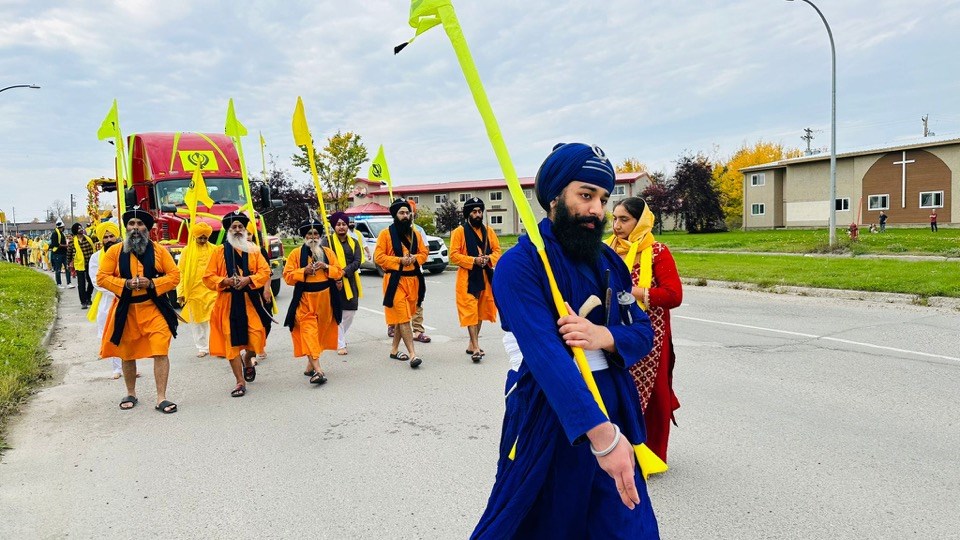The Sikh Society of Thompson joyously celebrated the Pehla Parkash Purab of their revered Guru, Sahib Sri Guru Granth Sahib Ji Maharaj, on September 23 and 24 at Gurdwara Sahib, Sikh Society of Thompson. The festivities were followed by a Grand Procession under the leadership of Sahib Sri Guru Granth Sahib Ji and Panj Pyaras (Five Beloved Ones).
The program commenced on September 23 with Evening Prayers and a Keertan (singing of sacred hymns) at Gurdwara Sahib, followed by Guru ka Langar (a free community kitchen). On September 24 (Sunday), the program began with Morning Prayers at Gurdwara Sahib, followed by another Keertan program, Guru ka Langar, and then Nagar Keertan (Religious Procession). The procession started from Gurdwara Sahib at 111 Goldeye Cres, proceeding through Thompson Drive, Giant Tiger, RDPC, Thompson Library, Cree Road, KFC, Thompson Dr, and concluded back at Gurdwara Sahib, 111 Goldeye Cres.
Historical Significance of Guru Granth Sahib
In September 1604 A.D., the Guru Granth Sahib, initially known as Adi Granth, was installed for the first time. Sri Guru Arjan Dev Ji, the compiler and editor of Adi Granth Sahib, bestowed the sewa (service) of installation upon Baba Buddha Ji, the first Granthi, who took the first Hukamnama (Guru’s Order of the day) from Adi Granth Sahib.
The Guru Granth Sahib was first compiled by the Fifth Sikh Guru, Arjan Dev, in 1604 in the city of Amritsar, Punjab, India. Its second and last version was finalized by Guru Gobind Singh at Damdama Sahib in 1705 and was later designated as the Eternal Guru in 1708 at Nanded, Maharashtra, by the tenth and last human Guru, Guru Gobind Singh. Sikhs respect the scripture as a Living Guru. It is kept on a raised platform under a canopy in Sikh temples, known as Gurdwaras, and Sikhs typically bow before it out of respect when they enter the prayer hall.
Inclusivity and Unity in Guru Granth Sahib
The Guru Granth Sahib contains Bani (sacred hymns) from 6 Sikh Guru Sahibs, 15 Saints, 11 Bards, and 3 Gursikhs (disciples of Sikh Gurus). It is the only scripture of its kind, encompassing songs, hymns, and utterances from a diverse array of saints, sages, and bards. Notably, a substantial part of the volume includes compositions from Hindu bhaktas, Muslim divines, Sufi poets, and other spiritually elevated souls. Their hymns and couplets, rendered in their own idiom, find a ready correspondence in the songs of the Sikh Gurus. Evidently, Guru Arjan Dev aimed to affirm the fundamental unity of all religions and the unitary character of all mystic experiences.
The Guru Granth Sahib embraces the compositions and utterances of high-born Brahmins and proud Kshatriyas, as well as the so-called lowly Shudras and unlettered Jats, at a time when the caste system in India had paralyzed the conscience of man.
Guru Granth Sahib: A Unique Scripture
The Guru Granth Sahib is a sui generis scripture in the world. It is a magnificent compendium of religious, mystic, and metaphysical poetry written or uttered between the 12th and 17th centuries in different parts of India. Simultaneously, it reflects the sociological, economic, and political conditions of those times. The satire on the reactionary and tyrannical rulers, the obscurantist clergy and sects, and the fake fakirs is open, uncompromising, and telling. While showing the path to spiritual salvation, the Guru Granth does not ignore the secular and creative side of man. It stands unique among the world’s great religious scriptures, considered the sovereign, spiritual authority, serving as a guide for Sikhs on all aspects of life, and promotes a message of equality, humanity, and universal understanding.




